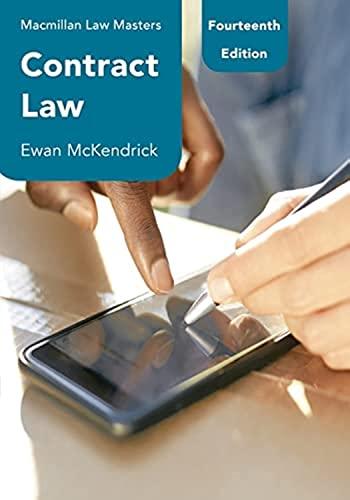Question
Reyes As discussed in class yesterday, Part Three of your midterm will be due next Thursday, March 21 st . Part One was to paraphrase
Reyes
As discussed in class yesterday, Part Three of your midterm will be due next Thursday, March 21st. Part One was to paraphrase the First Amendment. Part Two was to submit your three freedoms and corresponding Supreme Court case for each freedom for my approval.
Approval cases:
Three Freedoms and Supreme Court Cases:
1. Freedom of Religion:
Case: Church of the Lukumi Babalu Aye v. Hialeah (1993) Summary: This case protected the right of a religious group to practice their religion, even if their practices were unfamiliar or unpopular with the surrounding community.
2. Freedom of the Press:
Case: New York Times Co. v. Sullivan (1964) Summary: This landmark case established a high bar for public officials to win defamation lawsuits against the press. It protects robust reporting on government activities.
3. Right to Assemble:
Case: Edwards v. South Carolina (1963) Summary: This case protected the right of peaceful protest, even if the protest is unpopular or disrupts some level of social order.
1. Freedom of Religion: Church of the Lukumi Babalu Aye v. Hialeah (1993)
The Case: This landmark case involved the Church of Lukumi Babalu Aye, a Santeria congregation in Hialeah, Florida. Santeria practices animal sacrifice as part of their religious rituals. After the church announced its establishment, the city passed ordinances prohibiting animal sacrifice, seemingly targeting Santeria practices.
The Issue: The central question was whether the city's ordinance violated the Free Exercise Clause of the First Amendment, which protects the right to practice one's religion without government interference.
The Court's Decision: The Supreme Court ruled in favor of the Church of Lukumi Babalu Aye. The court found that the ordinance targeted a specific religious practice and did not have a compelling government interest to justify such a restriction. This decision established a strong precedent for protecting religious freedom, even for minority religions with unfamiliar practices.
2. Freedom of the Press: New York Times Co. v. Sullivan (1964)
The Case: This case arose from a full-page advertisement published by the New York Times criticizing the Montgomery, Alabama police department's response to civil rights protests. L. B. Sullivan, a Montgomery commissioner, sued the Times for defamation, claiming the ad falsely portrayed him and the police department.
The Issue: The case centered on balancing the First Amendment's protection of a free press with the right to protect reputations from false statements.
The Court's Decision: In a landmark decision, the Supreme Court established a "public official" standard for defamation lawsuits against the press. Public officials must prove "actual malice" - knowing falsity or reckless disregard for the truth - on the part of the publisher to win a defamation case. This decision protects robust reporting on government activities and discourages public officials from using defamation lawsuits to stifle criticism.
3. Right to Assemble: Edwards v. South Carolina (1963) The Case: This case involved civil rights protests in South Carolina. Student demonstrators were arrested for protesting segregation at the South Carolina State House.
The Issue: The case centered on the First Amendment's protection of the right to assemble peacefully and express dissent, even in the face of potential disruption.
The Court's Decision: The Supreme Court ruled in favor of the protestors. The court recognized that peaceful protests, even those that cause some level of disruption, are essential for a healthy democracy. This decision safeguards the right to public assembly as a tool for social change.
Please do not begin to write your paper unless you have received my approval. The following are the guidelines for your exam paper. Remember that your paper should be at least three pages long (one for each freedom/case).
FIRST AMENDMENTEXAM -PART THREE
There have been many Supreme Court cases that involve theFIVEfreedoms as laid out in The First Amendment:Freedom of Religion,Freedom of Speech,Freedom of the Press,Freedom to Assemble, andFreedom to Petition the Government.
Amendment I: Congress shall make no law respecting an establishment ofreligion, or prohibiting the free exercise thereof; or abridging the freedom of speech, or of the press; or the right of the people peaceably to assemble, and to petition the government for a redress of grievances.
PART THREE:Due on Thursday, March 21, 2024
You are to write three short essays, one on each case.
The first part of your essay should be a summary of the case (parties involved, where, when, what the case was about and the decision that was made by the Supreme Court.
The second part of your essay is your opinion on the ruling. Include one or more comments made by one of the Supreme Court Justices. Did they get it right or wrong? Fully explain your reasoning.
REMINDER: Do not lift the information from any site and present it as your own. This is plagiarism and it's an automatic fail.If you stick to the format of listing the specifics for the 5W's, you can avoid plagiarism. write my work in own work please Donn't just copy and paste
Step by Step Solution
There are 3 Steps involved in it
Step: 1

Get Instant Access to Expert-Tailored Solutions
See step-by-step solutions with expert insights and AI powered tools for academic success
Step: 2

Step: 3

Ace Your Homework with AI
Get the answers you need in no time with our AI-driven, step-by-step assistance
Get Started


